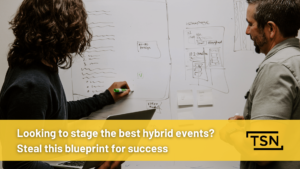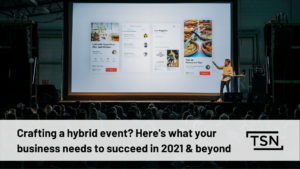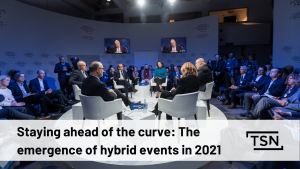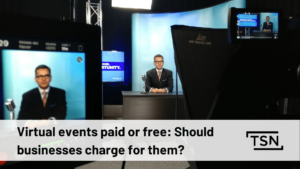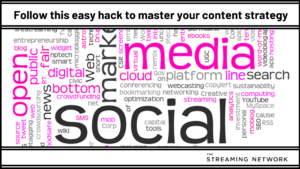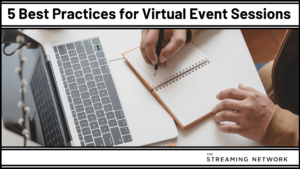Podcast: Play in new window | Download | Embed
Subscribe: Apple Podcasts | Google Podcasts | RSS
Lessons From The Frontline
As 2018 comes to a close, we’d like to finish off with our year-end retrospective.
Specifically, what worked for some industries and how webinar marketers like yourself should prepare for 2019.
We will be tackling the following topics:
- Which industries made a breakthrough in the webinar world?: Discover what legal, financial and tech marketers have been up to this past year.
- How should webinar marketers prepare for 2019?
- What is TSN going to focus on in the new year?: Creating new material to show you, front to end, how to execute the perfect webinar.
- What is going to happen in the world of webinars for marketers?
The Complete Video Transcript
Peter Vamos: Welcome back to LFTF. The show that marketers interested in Webinars or inbound marketing cannot do without. With me, as usual, Matthew Ley, President of the Streaming Network. This is part two of our year-end review. We’re going to–we’ve had some great insights in the last episode, and we’re going to keep digging into that and I think we’re going to talk a little bit as well about the year to come. So, Matthew–
Matthew Ley: Yes. Here we go again.
Peter Vamos: Here we go again.
Matthew Ley: Let’s go.
Peter Vamos: What was the most significant thing you came to understand this year about your business at the Streaming Network?
Matthew Ley: That’s a great question because as we plan for next year, and we look at our successes, where we grew, where we lost. I think after years of converting from an event-based business to a selling a software as a service, we really this year recognized that our customers require that be–to be successful, they require the service layers that we offer and even more of them within their Webinars and their Virtual Event Program.
And so, this model of software plus services was–has really emerged and the mix within our top customers is so drastically different than it was last year. The wins when we measure them are so drastically different. And so, this gets into the fact that we understand virtual. Ten years in, people have worked here for a very long time, they really get–they really get the game. We live, eat and breathe it every day. And so, even things like the inbound strategy to recruit viewers for Webinars, we’ve started offering that to–to customers. Not displacing their agency or anything, it’s about getting the right viewer to the Webinar.
The ways in which this studio is being utilized to fuel Webinar programs, but also other content around it, and the way that we’re–we’re, I guess, supporting on site, which really hasn’t changed that much in ten years. You know, I did a–a meeting with our director of events, Brian Squire, and I asked him, you know, what are the watch outs? What are the things that I need to know? What’s different? I haven’t been on site. I’m not show safe as we call it anymore.
And, you know, he was like, it’s exactly the same. And it’s just now, you know, we just have to check more. There’s a lot of different nuances which I’m sure we’ll talk about on one of these. So, it’s been interest–an interesting role from, you know, call us and we’ll book you an event, selling the software, to now, a software is the start. The base, and these are all of the other things that we bring to the table around it.
So, it’s–it’s–I think it’s been one more identity change for us as an organization, but I like it because I think it brings us back to the roots of when we started this business some ten years ago. And we wrote down how we wanted people to look at us. I wrote down that I wanted to be known as the experienced company. I never said I wanted to be known as a software company.
Peter Vamos: Right.
Matthew Ley: I wanted to be known as the experienced company. The company that people know to go to when they want that experience. And I think we’ve always done that, but I’m–I’m very happy with–with what we did this year and what, you know, that focus being back, you know, front and center.
Peter Vamos: And the ability to provide the strategic insights. Not execute the strategy, but really be able to say this is why you’re doing this thing. This is how it fits into everything else you’re doing, right?
Matthew Ley: Yeah. And–and yeah. And it’s come so far because now it’s–it’s not just the, you know, how–how to technically deliver.
Peter Vamos: Yeah.
Matthew Ley: It’s not we will do this for you. It’s let us understand what your goals are for this program, number of viewers, even accounts, pipeline growth. And start talking to them about what their plan was versus what we’ve seen work on our side. And–and yeah, so, it’s great to be that embedded within the program because as you all know if you’re watching this whole thing and this isn’t your first, or listening to it, you know that at your company there’s a marketing team of sometimes one, usually greater. Marketing teams are drastically expanding.
But those who do Webinars is what? Probably just you, maybe you and one other person when you’re sick, right. So, we are the team. Us and the Webinar webcast virtual members. So, we are the team that’s working together to make this happen to help the overall organization achieve their–their–their marketing goals really.
Peter Vamos: Right, right. So, that’s great. In terms of the year that has just passed, was there an organization or a sector that made a big breakthrough in Webinars either in Canada or globally? Is there, you know, we–we’ve had our focus–
Matthew Ley: –Yeah–.
Peter Vamos: –For many, many years. But is there–because there’s any organization or sector that you can highlight that said like, they made a big breakthrough this year in terms of using Webinars to their full advantage?
Matthew Ley: You know what? That’s a–that’s a tough question because as you ask it, I was–I was rolling through the answers and there’s almost an answer per sector.
Peter Vamos: Um-hmm.
Matthew Ley: So, legal.
Peter Vamos: Um-hmm.
Matthew Ley: Been doing it for a very long time. Change occurring and actually looking at these traditionally CLE driven programs as proper marketing initiatives. And going from behind a gated, hidden wall to being front and center and part of their conversion funnel. Financial services, drawing straight lines between advisor engagement and MQL and data. Words that a year and a half ago were never being spoken in the board-room. And an understanding that this–this program that they run is one of the biggest touch points they have with their top customers in the asset management world.
And so, they need to deeply analyze and really work through the data, which was, I will say with honesty, I mean, they–they look for integrations a couple years ago, but when we ask questions, the other guys are like, we’re just doing it. We’re not sure yet. And now they are. So, they were behind on that even though they were ahead on the Webinars.
Peter Vamos: Right.
Matthew Ley: You know what I mean.
Peter Vamos: Right.
Matthew Ley: Tech companies who were huge in Webinars, and now they’re part of that explosion I talked about in the hybrid events. They’re actually booking smaller, physical events so that they can reach out to people and do the back and forth. So, now they’re becoming a webcast or a hybrid event customer when they used to just be a software customer. So, I think the–the, you know, the thing, if I will say, is that the–as I mentioned, usage is growing everywhere.
And–and what we’re seeing is a lot of different sectors, I guess, catching up on where they were inefficient or lack the efficiencies in the past or behind if you will, maybe not efficiencies, were behind. So, yeah, it’s been–it’s been an interesting year that way. And this holds, not just for our customers, because it’s not just that slant, as we’re winning deals, generally where we’re winning, it’s people who are trying to do this and cannot, which is always the case.
You come to somebody when you can’t do it with your current platform. But what we’re seeing is they’re trying to expand their overall virtual event offering because they’re recognizing its value. And they’re struggling because of support platform or whatever to be able to effectively do that. And so, that’s where we’re winning when we do the win-loss analysis on those customers that we’re working on.
Peter Vamos: Okay, great. Alright, let’s–we’ve covered 2018, let’s do a little bit of the look forward as we wind this down. So, what gives you pause? What–what do you–if you’re looking forward–
Matthew Ley: –Yeah.
Peter Vamos: –Then not to be too–too much of a bummer, but what gives you pause? What would you caution clients about in the coming year?
Matthew Ley: Overthinking it. You know, we–we the world of marketing changes so quickly. And you need to be a fast follower. There’s a reason why, you know, things are happening. But as it relates to your Webinar program, I really wouldn’t overthink it. The–you’ve probably been producing content by pipeline for the–a section of the pipe-line wherein as post sell, all the things for a while. And just because, you know, you’re under pressures to create more content, just because your battle for people’s time has gotten even harder and harder.
That doesn’t mean you need to over think and make your program just, you know, a blow it up, or anything like that. The key is being, I think, just more intelligent and efficient about what you do going back to, you know, what we’re seeing with a lot of our customers. And the other thing that I would caution about is this idea that all–everything has to be unique. Every piece of content does not have to be a–a snowflake. And you don’t need to keep reinventing the wheel, especially as your part of what is, basically you’re attracting–what is marketing, right? Attracting new customers into an organization.
Is that most of the people who are going through your program, haven’t seen it before, right?
Peter Vamos: Right.
Matthew Ley: It’s not for the person who already bought, who already went through that–that journey. And so, you know, you can really effectively use content that is a year or two old, unless there’s been drastic changes in your market or–or in your products set. So, that’s what I would caution people on. I would–I would, yeah, I think that’s–I think that’s the biggest caution because we are getting into some very deep conversations now around tech, ABM, automations, NOD, and this and that. And I think that they can cloud, you know, they can–they can cloud the what the real conversation should be.
Peter Vamos: Got you. Okay. That’s great. What are you most excited about for 2019? What’s got you all jazzed up?
Matthew Ley: Well, I’m super excited about–I’m super excited the, just the conversations I’m having with senior marketers about what they want to do, you know. A lot of us, or a lot of people who go into marketing probably at some stage thought about being in film or television.
Peter Vamos: That’s good.
Matthew Ley: You know, journalism, all that stuff, right. Hey, you know, I never went down that road, but, you know, I love movies. I make movies with my son.
Peter Vamos: Um-hmm.
Matthew Ley: And whatever, and so, now that they’re embracing the virtual side of it, they’re embracing it in a fun way, which is going to hopefully, you know, wake Webinars up and virtual events up a lot more. And so, you know, we’re having conversations about, you know, just how to create a show, or how to make an engagement that much better. And you know what? They’re the right conversations.
Peter Vamos: Yeah, yeah.
Matthew Ley: Because for a while there, you know, we were the ones having that. It was like one way. You need to make your Webinars more engaging. Well, why Matt? Because they’re boring. Well, why does it even matter? People come and whatever. I’m like, no. You need to do that, so you can see who’s really into it. You have no idea who’s into it if they’re just watching slides for 45 minutes, because you only get what, three questions at the end?
Peter Vamos: Yeah.
Matthew Ley: Yeah, right. So, we’ve been harping on that. And now, we’ve got people coming back to us and saying, hey, this is what we want to do. And a lot of the ideas are really awesome and really good. And, so that’s fun. I love being a part of that. I love seeing or hearing on the other side of the phone or seeing on the other side of the table the excitement for this industry that I’ve always had that for I know, I think, for a very long time was not, you know, top of mind for some of these folks.
Peter Vamos: Yeah, you’re putting on a show.
Matthew Ley: Yeah.
Peter Vamos: Right. Okay, and as an organization, what are we going to focus on in the next year? What’s you’re–what are your priorities?
Matthew Ley: Well, I think as it relates to our marketing and as it relates to what we do here and with other things, it’s the how. So, what–the feedback that I’ve been given is, you know, that’s fine, Matt. You know, you’ve got these shows. You talk about these things and, you know, you drop a, you know, an e-book or you do whatever, but we want to know how, start to finish, so that we can do it.
And we’ve been working with some–some partners , and Demand Metric and alike, and trying to pull together some tools and assets and we’ll make sure that when we’re here and for the first part of next year, we answer that question of how. How do you execute on a hybrid event to make sure that there is no errors? How do you, you know, effectively, you know, create content that really performs well, but matches to the buyer’s journey? How do you use the data that you get from Webinars and relate it to the other data that you have to understand sales readiness or not?
How do you use Webinars effectively within an ABM strategy? All that stuff, how. And so, for that, you know, I’m going to need to rely on other people a little bit. I need to go out and talk to, you know, more in depthly, our customers and what not. But that’s going to be a big part of what we–that enablement is going to be the next stage in what it is that we do.
And from a business perspective, or a company perspective, it’s going to be about creating products or offerings that are easily consumable by the customers for things from studio to, you know, audience recruitment, to some of the stuff that we do as part of our subscription, the data analysis and stuff. But going even deeper on that to help people accelerate. And looking for gaps and their traditional marketing group or agency relationships as it relates to virtual, and then filling those gaps.
Peter Vamos: Um-hmm.
Matthew Ley: Is it selfish? A strategy to get more wall share out of our customers, but it’s also a–what we’re seeing more and more is that it’s just not a focus of traditional marketing agencies, organizations in the like. We’re just one–Webinar is just one part of the overall mix. And that is true. And we have an opportunity to go beyond market share leader and, you know, to being a bigger partner with everyone. And really being the overall, sort of, thought leader, people driving what’s going on in the country. And that’s how we’re going to–how we’re going to proceed.
Peter Vamos: Alright, great. I’ve got one more question.
Matthew Ley: Sure.
Peter Vamos: This wasn’t planned.
Matthew Ley: Alright.
Peter Vamos: And I want both of us to do this. I want–let’s both make predictions for 2019. What is going to happen in the world of Webinars for marketers in 2019? I can start.
Matthew Ley: Okay, yeah.
Peter Vamos: Because I haven’t even let you think about it.
Matthew Ley: Yeah.
Peter Vamos: I’ll give you my prediction. And I’ve actually got two predictions. One prediction is that cannabis is going to play–start playing a big role in marketing. I don’t think the cannabis business is out there. I think they’re still right now trying to navigate a very consumer centric world. Meanwhile, this is an entire sub-sector of cannabis which is speaking directly to doctors and medical professionals. They haven’t quite grasped what the power of–
Matthew Ley: –Yeah–.
Peter Vamos: –Using Webinar platform, getting those advocates within the medical community. I think we’re going to see a lot more start to grasp that kind of communication, that kind of thought leadership, is important as–especially as a couple can get slapped down for putting, you know, beautiful people on CD smoking dope on, you know, out there on images, which they’re not supposed to do. They’re going to try to figure out different things.
So, that’s one. And I think the second thing, we’ve talked about this quite a bit is, I believe that the use of Webinars as a foundational piece of content that then gets cut down and creates, you know, the–the–a whole bunch of other content, videos, white papers, things like that, is going to become more and more prevalent as businesses try to figure out how to do more with the dollars they’re spending. So, those are my two predictions for 2019.
Matthew Ley: Well, I think–I think in 2019, we are going to see some pretty exciting changes in our marketing stack that are going to really, really impact the Webinar. And this is going to be in relation to personalization. And there’s–there’s some stuff going on right now within the Microsoft dynamics, 365 for marketing. Some of their early work on integrations with our platform are very interesting. Like they started at the end. They started with things that, you know, we’ve never seen before.
You know, within their marketing automation tool, they can grab a sub-section of people, recognize them, click a button, and that triggers an event to be built in the system along this line of getting the right message in front of the right people, which is–was an interesting place for them to start with their integration.
And so, it they’re thinking that way, I can only imagine what’s going on over, you know, within like Marketo or the ABM–or the ABM platforms. And I think that in general, like our customers are using, you know, one company and tool for their Webinars and one company and tool for their webcasts and another company and tool for this, to go to Facebook and all of that. And what we’re going to see in our spaces is continue the same story, is condensing of all of these things into one platform. So, you have one place where everyone’s coming in and getting the data.
Is that on the front end of it? There’s going to be some convergence in tech I think, that is going to make all of the things that we talk about, and all of the things that, you know, you’re trying to do as marketers a lot easier with Webinars. I don’t want to–I don’t want to guess that all the stuff’s going to happen this year, but, you know, I’ve been in some conversations with various developers that are on 24 and some of these other companies. They’re saying this is what’s–this is what’s going to happen, right.
Peter Vamos: Right.
Matthew Ley: And it’s super exciting. And so, and so, yeah, so, I think that this year is going to be a very interesting year, both behind the scenes from a technology perspective, and in front of the scenes with the stuff we’re going to be talking about, whether it be cannabis, whether it–you know, whatever–whatever it is. And so, I’m still going to finish out the year strong, but I’m excited about–I’m excited about next year.
Peter Vamos: Yeah. I am too. That is it. Once again, thank you, Matt, for this very insightful look back and look forward. LFTF, we are done for the year. But it is Podcast for marketers who are interested in Webinars, inbound marketing, any ways to move your–move customers into your pipe-line. We’ve got–we’ve got great, great insights. Webinars are a critical component to your marketing mix. That’s my end of the year pitch.
Matthew Ley: Okay.
Peter Vamos: Why you should be using Webinars. Thank you very much and we’ll see you again next year.
Matthew Ley: Thank you.

